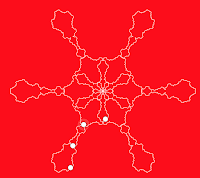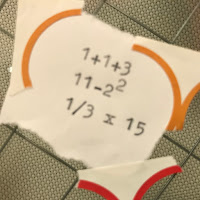Welcome to the 151st edition of Denise Gaskin's Playful Math Education Carnival for November/December 2021. That's a lot of good math that has been shared, but I'll try to narrow it down. Thanks especially to Iva Sallay and Denise herself who had good suggestions for links.

Lagrange's theorem tells us that each positive integer can be written as a sum of four squares. But some of them can not be written as the sum of less than 4 squares, and 151 is like that. What are the four squares?
Make

Paula also had a great post reviewing her month of making Johnson Solids. She's been doing Saturday half hour folding sessions that are the epitome of playful math making.
Jenna Laib shared a tweet thread about a quick drawing game that got kids thinking. Update: she wrote a blog post about it!
Can't have one of these without a Simon Gregg post. Here his learners are building Number Blocks, a show he's already converted me to.
Vincent Pantaloni shared a Set game (a Set set?) with just geometric symbols. I think it could be really challenging.
Just shortly before publishing, Jonathan pushed send on a post about haikus and magic from having a typewriter in his classroom. My favorite was this, which he admitted was his own! I shared that in grad school we loved numbers that could be haiku, like 32,518,460. He added two more on Twitter:1, 2, 3, 4, 5, 6, 7, 8, 9, 10 and 11. That's enough.
2.71 8281828 45 and so on
Play, Game & Puzzle
Back from May, but spot on theme, Peter Rowlett writes about Math Play with Young Children.
Annie Forest shared a place value, low materials math game called Draw 10 that she first wrote about a few years ago.
There were 151 original, or Kanto, Pokemon. (Mew is 151) I'm a big believer that strategy games of any type help develop problem solving, and sometimes number sense. Collectible card games add a lot to that, with deck construction and variety of situations adding more problem solving.
Iva Sallay crosses Sarah Carter and Joseph Nebus and makes a puzzle!
Colleen Young connects to a bunch of math puzzle resources.
Patrick Vennebush is working out a better multiple choice test in his Mathy Jokes blog.
Content
Bumba Stories has a short history of why we have 12 months.
The Quiet Pond has a review of what looks like a good picture book, Danny Chung Sums It Up.
Christopher Danielson share's one perfect page from The Last Marshmallow.
Speaking of counting, Early Math Counts has some early math winter counting opportunities.
Dave Taylor started a Twitter thread about historical numerals by starting with the Cistercian numbers.
Brian Bushart shared one of his favorite resources, a free collection of math interventions, Pirate Math Equation Quest. It is not all pirate themed, but lots of great supporting materials.
One-Fifty-One is a hard rock band... not my taste, but if it's yours, rock on.
Jenna Laib had a great geometry post about the half triangle. If you listen closely, you can hear the learners progressing van Hiele levels.
If you're looking to stretch your brain, try Jim Propp's monthly essay, this time on numbers from games. Bonus John Conway stories.
Katie Steckles wrote a sweet piece for the Aperiodical about Spirograph Math.
I should be blogging more... and if I did, I would definitely write about the interesting responses to this tweet about dividing polynomials with partial quotients.
TeachingDylan Kane, always challenging, provocative and brief, takes on productive struggle.
David Sladkey wrote about implementing some of the Thinking Classroom ideas with his learners. Practical and productive.
Margie Pearse wrote a post for Heinemann on using literature to address social justice in math.
Dan Finkel's reflecting on a big question "Am I a Mathematician?"
In Memoriam
We'll close with Math Ed Podcast's interview of Dr. Liz Fennema, one of the founders of Cognitively Guided Instruction. She passed away this month in hospice. She received the NCTM lifetime achievement award this year, at least partially in response to a public campaign. CGI might not be playful in the same way as many of the resources shared here, but with their focus on improving learning for children, and listening to children's inherently playful approach to mathematical problem solving, they moved all of us forward. She also did significant work on gender in math education. Rest in peace, Dr. Fennema.Cheers to a mathy new year! I know champagne is more typical, but where's the 151 in that?





















